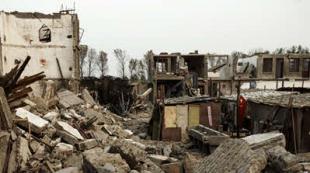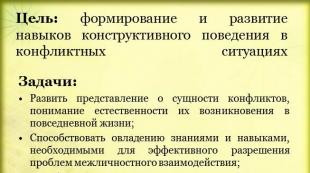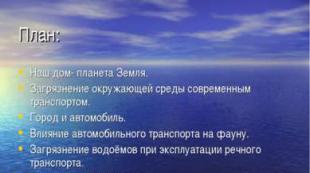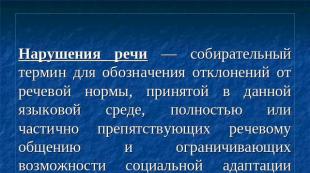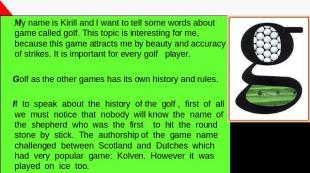Presentation "What is Minigolf?". Golf Topic in English History of the UK Sports Committee
Municipal budgetary preschool educational institution kindergarten No. 73 "Dolphin" What is this "Mini-golf"? Prepared by: physical education instructor of the 1st category Podborodnikova O.V. Tolyatti 2016 Purpose: To give children an idea about the game "Mini-golf" Tasks: to acquaint children: - with the history of the development of the mini-golf game; -with varieties of playgrounds for playing mini-golf; - with the basic attributes for playing mini-golf (clothes and shoes for playing mini-golf, club, ball) - with the concept of playing mini-golf; - with the etiquette of golfers; - with the peculiarities of the terminology of the mini-golf game; Mini golf is a miniature version of golf, a sports game in which individual participants compete by driving a small ball into special holes with pater strokes, trying to cover the allotted distance in the minimum number of strokes. For the first time the game of golf was played by shepherds in Scotland. They used staffs to drive pebbles into rabbit burrows. Since then, the game began to spread around the world. The first official golf tournament took place in Scotland in the 19th century. The formation of minigolf as an independent sport is now officially attributed to 1953, when the Swiss architect Paul Bongini built the first specialized minigolf course in its modern sense and patented the name Minigolf. The first Minigolf World Championship took place in 1991. The minigolf course does not have strict requirements for size and shape. For this sport, there are a large number of sites. Paths of a free standard or a landscape field. Eternite course Modular mini golf Country mini golf Realistic mini golf Mini golf equipment Small children also enjoy playing minigolf There are special minigolf sets for children with different obstacles Game concept fewer strokes to roll the ball into the hole.- First hit from the launch pad (tee). Subsequent hits from where the ball stopped. - After completing the hole, write down your score on the card. - If the ball is out of bounds, add two free kicks and keep playing with the tee. - If the ball has left the field of play over the tee (rolled down the slope), continue to play the tee without penalty. - If the ball comes to rest near a wall or obstruction, carry it up to the length of the club's heel without going near the hole, without penalty. - A ball rebounding from an obstacle is played from a new spot without penalty. - A ball that hits a closed obstacle is considered lost, the hole is lost (7 strokes). - The maximum number of strokes per hole is 6. If you miss the hole in 6 ulars, add one penalty stroke and move on to the next hole. - The winner is the one who has spent fewer strokes on all holes if the game is for the number of holes, or the one who has won more holes if the game is for holes. E T I C E T - Do not stand close to the kicker. - Do not distract a player preparing to strike with movement or conversation. - Never delay the game. - Let the player go faster than you. - After making a shot, get off the field of the hole. - Do not make swing movements with the club that imitate the game of big golf. It is dangerous for those around you. - Respect the player and the court where you play. GLOSSARY of minigolf terms
- Putter - mini golf club
- Ball - a special ball for playing mini - golf
- A hole is a hole in the playing field into which a ball is driven.
- An obstacle is an element of the playing field that complicates the game process.
- An obstacle is an object that "interferes" with the game and is on the field by design.
- The tee is the base on which the ball can be placed to make the first hit on each hole.
Golf is one of the most popular outdoor sports in the world. It is played on a golf course. Players try to hit a golf ball into a small hole with as few strokes as possible. Millions of men and women around the world play golf for fun, thousands of play tournaments and millions around the world watch golf on TV.
A golf course
Golf courses have different sizes and shapes. Most of them have 18 holes that are between a hundred and 500 meters long. If you have finished playing all 18 holes you have played a round of golf.
Each hole has a starting place, called a tee. This is a small area from which the golfer takes the first stroke or drive. The grass between the tee and the green is called the fairway. Sometimes fairways can be very long and golf players need a few strokes to get to the green. The land on the left and right of the fairway is the rough. It is made up of tall grass, bushes and trees.
The green is the round area at the end of the fairway. It has special grass that is very short. In the middle of the green is a hole. It has a flag placed in it so that golfers can see where it is.
Almost all golf courses have hazards. These are small lakes, sandy areas and bunkers. They make it more difficult for players to hit the ball.
golf equipment
A golfer needs a ball and a set of golf clubs to play golf. A golf ball is made of rubber and has a plastic covering. It weighs about 1.62 ounces (46 grams).
golf clubs
In a tournament golf players can use up to 14 different types of golf clubs. Each club is used to play the ball in a different situation. Generally, there are two basic categories of clubs: woods and irons. They are numbered from 1 to 9.
Woods were originally clubs that had a wooden head. Today they have heads made of steel or titanium. Golfers use woods to hit the ball over long distances. A number one wood is also called a driver. Players use this club to start their game at the tee.
Irons have heads that are thinner and flatter. Instead of iron, the club has a head made of steel or another metal. Irons are used for shorter shots and shots where you must play the ball very accurately. The putter is a club that is used on the green for very short distances.
Rules of the game
The rules of a golf game are very simple. Starting from the tee a golfer must hit the ball towards the hole. You must not touch or move it. It must be played from wherever it lands. If the ball lands in one of the hazards the golf player may take it out or use a new ball but then gets an extra stroke as a penalty.
Scoring and handcaps
In order to see how well you do every hole on a golf course has a standard score known as par. Par is the number of strokes it would take a very good golfer to hit the ball into the hole. There are 3-, 4- and 5-pair holes. Golfers have special names for the number of strokes they need compared to par.
Eagle = two strokes under par.
Birdie = one stroke under par.
Bogie = one stroke over par.
In a few cases a golfer may hit the ball into the hole from the teeing ground. This is called a hole-in-one.
So if you finish a round of golf on par you can think of yourself as a very good player.
The handicap system allows weaker and better players to compete with each other. Based on a very complicated formula a weaker player is allowed more strokes to finish the round.
Golf can be played in two ways. In match play the player who hits the ball with the fewest number of strokes wins that hole. The player who wins the most holes wins.
Stroke or medal play is more common. In this competition the player with the fewest number of strokes for the whole 18-hole round wins.
History of golf
Although the Romans may have played golf with a bent stick and a ball filled with feathers golf, as we know it today, started in Scotland in the 14th century. Saint Andrews is called the birthplace of golf because its golf course is over 500 years old. The first rules of the game were also set there.
Golf spread from the British Isles to the overseas colonies. The oldest golf club outside of Britain was founded in Calcutta, India. Golf came to the USA and Canada towards the end of the 19th century. Although British golfers dominated the sport at first, great American golfers emerged at the beginning of the 20th century. In 1916 they formed a professional organization, the PGA, in which they started to earn money through golf.
Players like Severiano Ballesteros of Spain, Bernhard Langer of Germany or Gary Player of South Africa made golf popular in Europe and other continents. In the last two decades the American Tiger Woods has dominated the game.
In the 1960s more and more companies, private sponsors and television networks started to pour money into golf. Today the best golfers in the world earn millions of dollars in prize money every year. Tiger Woods became the first athlete to become a billionaire.
How did golf come about? It is believed that the game of golf originated in Scotland and was invented by shepherds who, with the help of staves (future clubs), drove stones into rabbit holes. Presumably the game already existed in the XIV century, and in the XV century in Scotland several laws were passed prohibiting the playing of "golf". In the 17th century, balls were played with clubs already in the Netherlands. The game in its modern form took shape in the 19th century in Scotland. Golf in Scotland by shepherds

GOLF COURSE 1 - Teeing ground, 2 - Water hazard, 3 - Rough, 4 - Out of bounds, 5 - Sand bunker, 6 - Water hazard (water hazard), 7- Smooth field (fairway), 8- Green (putting green), 9-Flag (flagstick), 10 Hole (hole)

TERMS A putt is a light shot played on the green (the part of the course that has the shortest grass and also where the hole itself is located), the main purpose of which is to hit the hole. A slice shot in which the ball flies straight but then deviates significantly to the right (for a player with a right-handed stance). Par is the number of strokes in which a player must complete a hole. There are three varieties of "PAR" are par-3, par-4 and par-5, the main difference of which is the distance from you (starting place) to the hole. Very rare, but still found and par-6. On average, the distance ranges from 100 to 550 meters. For example, par-3 (110 meters), par-4 (320 meters) and par-5 (480 meters). Hol-in-van ("Hole at a time") hitting the hole from the box. Birdie ("Bird") the number of strokes is one less than PAR. Eagle ("Eagle") the number of strokes is two less than PAR. Albatross Strokes Three Under Par (par 5 and 4 holes only) Bogey Strokes One Over Par. The caddy is the player's assistant, whose duties include carrying sports equipment and providing advice. caddy

COUNT NAME DESCRIPTION Hole in one hitting a hole from a tee box -3Albatross three shots lower than par -2Eagle two shots lower than par Birdie one shot lower than par EPar is the number of strokes a golfer must take on one hole +1 Bogey is one more than par +2 Double bogey is two more than par +3 Triple bogey is three more than couples

STICKS A player can use no more than 14 types of golf clubs to play golf. Wood clubs (Eng. Wood) a club with a massive head and an angle of impact plane from 7 ° to 15 °. Woodom the ball is put into play. Allows you to send the ball to a distance of up to 300 meters ("Driver").eng. Iron (eng. Iron) is a lighter stick with a spade-shaped head for aiming the ball at shorter distances. The angle of inclination of the impact plane is from 15° to 45°. The sticks are numbered. A larger number allows you to send the ball at a greater angle to the horizon for a shorter distance. Impact distance from 70 to 150 meters.eng. Vedzhi (eng. Wedge) differ from ayran even in a larger angle of the hitting surface (45 ° -64 °) and are needed to knock the ball out of a canopy, for example, from sand (Sand Wedge) or grass (Chipping Wedge) at a short distance.eng. Putter (eng. Putter) a stick with a light L-shaped head for playing on the green and applying stalemate rolling strokes with which the ball rolls into the hole.eng.


BALLS The surface of a regular golf ball is pitted (in order for the ball to better "hold" the direction in which it was hit) Air is trapped in the pits and an invisible shell is formed, which: reduces the oscillation of the ball during flight increases the lifting effect when hit with a twist of the ball Disadvantages standard surface: if the club hits an off-center hole, the ball is very likely to deviate from the given direction. To solve some problems, researchers offer various solutions. For example, instead of pits, Korean scientists suggest that grooves be applied to the ball, which will divide its surface into segments of various shapes (grooves create an air shell according to the same principle as pits). Since the surface area occupied by the grooves is less than the area on which the pits are located, then, according to the creators of such a ball, the probability of hitting the stick in the “wrong” groove is less than in the “wrong” hole [ [



GOLF IN SPACE The first hit with a golf club in space was made by astronaut Alan Shepard on the surface of the Moon during the Apollo 14 expedition in 1971. The first time he simply missed the ball with a stick, but the second time, due to the weak lunar gravity and lack of atmosphere, the ball flew several kilometers and was lost for further play. During a spacewalk on the International Space Station, he hit a golf ball as part of a promotion by the Canadian company Element 21 (“the 21st element”). The blow was delivered with one hand. Michael Lopez-Alegria filmed the impact of a Russian colleague. Special clubs and balls were delivered to the ISS. The spacewalk was carried out from the Pirs docking compartment in Orlan-M spacesuits. November 23, 2006Mikhail Tyurin of the International Space Station PirsskafandrakhOrlan-M A golf ball, which is space debris, will not pose a danger to the ISS and, upon entering the dense layers of the atmosphere, will burn out. Just in case, Mikhail Tyurin had three balls at his disposal. Space debris dense layers of the atmosphere


THE TOURNAMENT Major men's professional tournaments include the Masters, the US Open, the British Open, and the PGA Championship. by a vote against 27 it was decided to include golf in the program of the Olympic Games 2016 in Rio de Janeiro



MINI GOLF A miniature golf or mini golf game that has been developed since the middle of the 19th century. A mini-golf course is a green on which the path of the ball to the hole is hampered by numerous obstacles in the form of stones, sand traps, artificial labyrinths, and so on. The player's task, as in ordinary golf, is to pass the ball into the hole in the minimum number of strokes. The game is played only with a potter stick, swing is prohibited by the rules. Often, minigolf holes are equipped with decorative decorations, for example, in a historical style, and also have non-standard ball paths to the hole: gutters, tunnels, mechanical lifts, traps, false puts that return the ball to the “you”, and so on. Despite the general recreational style of the game, competitions are also held in mini-golf, including international ones.

slide number 1
Description of the slide:
slide number 2

Description of the slide:
My name is Kirill and I want to tell some words about game called golf. This topic is interesting for me, because this game attracts me by beauty and accuracy of strikes. It is important for every golf player. Golf as the other games has its own history and rules. If to speak about the history of the golf , first of all we must notice that nobody will know the name of the shepherd who was the first to hit the round stone by stick. The authorship of the game name challenged between Scotland and the Dutches which had very popular game: Kolven. However it was played on ice too.
slide number 3

Description of the slide:
1457 - The first written mention of a golf in the decision of parliament of Scotland. King James forbade this game because solders neglected bow shooting training - instead of it they constantly played golf.1744 - Edinburg society of golf players makes the first list of rules. One of thirty rules regulates “carrying” the ball out of the water accumulated on the field. 1848 - The balls mode of feather , were replaced by unicomponent rubbery. 1922 - The golf became business. The first time in a history of golf the tickets were sold for the game. Earlier of visiting tournament was completely free of charge.1922 - Walker cup (the first international team tournament in the history of golf) began from an easy victory of Americans above the amateur combined team of UK.1947 - The golf was shown on TV for the first time.
slide number 4

Description of the slide:
And now its time to speak about golf’s rules.Golf is a game in which you need only ball, hole,golf club and a field where all these componentsunite to get unlimited pleasure. The game begins on the moment when the ball is to beaten by golf –club on specially prepared area, known as play ground “T” to the direction the other prepared area with hole on it, known as “putting green”. That mean shortly cut grass plat a round the hole. At this time ball's way is crossing two types of plats: “fairway” with grass of medium length and “rough” - long grass from the sides of fairway.The main point of the game is as people say , to pass the hole: that means that the player, beginning the game from T play ground, must to hit the ball into hole, located on patting green with minimum number of strikes. Golf circle consists of 18 games for holes.
Description of the slide:
There are two types of the game, one of them is defined by parity won and lost holes (match game) and the other defined by total number of strikes made for finishing the circle (game for count of strikes).You must remember three major principles in this game:- Play on a field as it is,- Play the ball as it has lain,- And if nether this nor that is possible, act fair. You must know the rules to act fair.Some time ago such type of golf as mini golf appeared.The mini golf has got popularity almost equal to a golf. There are few distinctions between them. But mini golf is obviously more convenient and available. The basic difference is that min: golf player uses only one golf-club for the whole game. This golf club is called putter. With the help of which player rolls up the ball into the hole. It is often used artificial covering of the field in mini golf.
"Popular sport" - Completed by: English teacher Polezhaeva M.A. Gymnasium No. 56. History of the British Sports Committee. The principle of British education: "A healthy mind in a healthy body". Very popular sports are also: Horse racing. Sports in schools. Rugby. The most popular sport. The support group is very good.
"Volleyball Games" - Volleyball game creator. Game technique. Broadcast. In modern volleyball, the most common power serve is in the jump. Basic tricks in the game. Volleyball is a team sports game with the ball of two teams. Libero. Upper and lower intake. The game of volleyball appeared in 1895 in the USA. Each technique has several ways to perform.
"Volleyball Rules" - Stoics of players. The player's stance in the game. Ball weight=260-280 grams Circumference=65-67cm. Founder William James Morgan. 1900 - the first rules are adopted. Top pass of the ball. Ball passes. Lower pass of the ball. Volleyball. When submitting. "Flying Ball" Founded in 1895. Volleyball rules. Violation of the rules of the game.
"Table Tennis" - Attributes. Tennis racket. A - Right lateral rotation. Table height - 0.8 m (30 inches). All movements of the players and the ball are described in geometric terms. The game takes place on a table measuring 2.7 meters (9 feet) by 1.5 meters (5 feet). There is a 15 cm (6 in) high net in the middle of the table. B - Left lateral rotation.
"Physical culture basketball" - Violation of the rules or attack from behind - foul. The World Basketball Championship is held every 4 years and the European Championship too. Later, the number of players was reduced to 7, and then to 5. The emergence of the game. Basketball is very popular these days. Table of contents. The development of basketball in foreign countries. Historical sketch of the development of the game.
"Types of games" - Everyone receives 2 batons inflated with air. - Introduce children to 3 types of games - Explain the rules of the game. 2 participants are invited to the site. . "Pass the baton"Two teams of 6 people. And so on until everyone is caught. Each team gets 1 flag. You got acquainted with three types of games: Games-attractions.
There are 38 presentations in total in the topic
